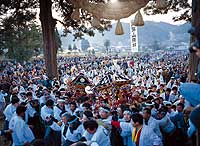
| Pseudonym reading | Maru Neji Matsuri Matsuri Festival |
|---|---|
| Specified type | Country designation |
| Type | Important intangible folk cultural property |
| Designated date | January 21, 1985 |
| Specified details | Ichinoseki City Murone-cho, Ichinoseki City Daito-cho, Ichinoseki City Senjo-cho, Ichinoseki City Kawasaki-machi, Ofunato City, Miyagi Prefecture Kesennuma City, Karashima Town |
| quantity | |
| location | |
| owner | |
| Holding group | Murone Shrine Festival Preservation Society |
| Management organization | |
| home page | Iwate's Cultural Information Encyclopedia (Matsuriva Event at Murone Shrine) |
Overview
According to the tradition, at the time of the creation of Taga Castle (early 8th century), Murone Shrine, which sits down on Mt. Murone, solicited Kumano Shrine in Kishu at the court as a main shrine for the conquest of the conquest of the Ono. It starts with
Kumanojin first landed in Tanggu, Miyagi Prefecture, and then settled on Mt. Murone, then collected land and sea faiths as the total guardian of Mutsu.
The festival has been held on the 19th of the year following the year of the rooster year, but its feature is that the descendants of the villages who have been involved in the festival since the time of the solicitation inherited the role that the ancestors served, and it is now inherited Serving to
This is a representative example of Kishu Kumano's Tohoku Senshu, and in particular, it is highly valuable in its religious beliefs that the gods from the villages keep their old form and serve in the traditional tradition.
Although the processions and so on are aired and glamorous, the old remnants of the sculpting are seen in the first battle of the shrine, and the remnants of the beach are seen on the tide of water from Tanggu, and so on. The form of is left as a distinctive customs and customs of the land and is valuable.
